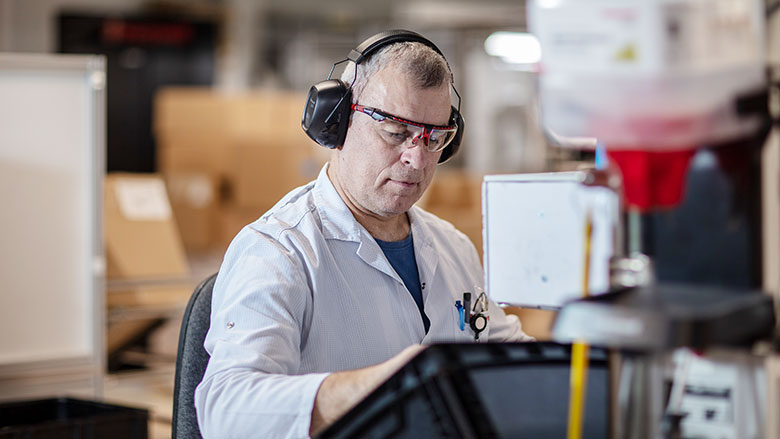The changing face of manufacturing
Keeping safety at the forefront as automation increases and labor shortages continue

Photo credit: Honeywell
Manufacturing is a long-standing staple of our economy. In the U.S., it contributes 10.7% of total output, and in Canada, it accounts for 10% of the gross domestic product (GDP).1,2 The three largest manufacturing categories in the United States are computer and electronic products, chemical manufacturing, and food and beverage.3 Electronic manufacturing in the U.S. has grown 162% from 2006 to 2021, while auto manufacturing has grown approximately 31% over the same time period. More growth is expected in the future with the accelerating adoption of electric vehicles (EVs).
The past decade has seen a massive change in the manufacturing industry, brought on by the increased use of automation, the pandemic’s impact, and an ongoing labor shortage. So, what have been the biggest changes? And how will the industry continue to adjust and innovate to meet new demands, while continuing to prioritize safety? The following changes are some of the most notable in shaping the industry both today and in the years to come:
Increased adoption of automation and robotics
Robotics in manufacturing often takes on highly repetitive jobs or tasks that are less appealing for human labor because they are higher risk, such as roles involving heavy lifting. Today’s robotic technologies incorporate advanced sensors, artificial intelligence (AI), and other capabilities that allow them to perform precise tasks with high levels of efficiency, helping to increase overall productivity for manufacturers.4
According to the International Federation of Robotics (IFR), total installations of robotics in manufacturing in the U.S., Canada, and Mexico grew by 12% in 2022 to reach more than 41,600 units. The automotive manufacturing sector is the largest adopter of these technologies, installing 30% more robots in 2022 than they did in 2021.5
Greater connectivity and intelligence
The terms “smart factory,” “industrial internet of things” (IIoT), and “Industry 4.0” have entered the manufacturing discourse, referring to how devices and machines are now increasingly interconnected so they can share information and communicate with each other. Through these advances in technology, the shop floor can be directly connected with decision makers, and production data can be collected and analyzed in real time, enabling timely operational improvements and better-informed decisions.6
As an example, gathering and analyzing data on equipment health over time enables predictive maintenance; rather than waiting for a machine to break down, requiring a last-minute scramble to find a repair technician and costly downtime, machinery can be maintained at optimal times throughout the year to increase the technology’s overall uptime.
Shifting labor demands
The National Association of Manufacturers (NAM) reports there are currently 13 million people employed by more than 240,000 manufacturers throughout the U.S., with an additional 4 million manufacturing positions expected by 2030.7 However, the nature of manufacturing work is shifting. As humans and machines are increasingly working together, new types of jobs like Manufacturing Cybersecurity Strategists, Digital Twin Architects, Robotics Technicians, Predictive Supply Network Analysts, or Smart Factory Managers will be required.8
This shift has led to a skills shortage, where many manufacturing companies are struggling to find labor with enough experience or the right skillsets to meet today’s demands. As a result, nearly 60% of manufacturers in a recent NAM survey indicated they are creating or expanding internal training programs for employees to help mitigate the skills shortage in the future.9
The pivotal role of safety
As these changes continue to evolve the manufacturing sector, safety for workers and facilities is just as important as ever. With humans and machines working alongside each other, there are several factors to consider:
Noise: With robots and automation technologies taking on many manufacturing roles — from welding, painting, lifting, and forging to stamping, forming, machining, palletizing, and assembling — the noise level in many factory environments is going up. Wearing appropriate hearing protection, such as ear plugs or passive earmuffs, is critical to safeguard workers’ hearing over the long term. Nearly half of all manufacturing workers have been exposed to hazardous noise levels, and 28% who are exposed to this noise report not wearing hearing protection.10
Vision: It is important to keep a clear line of sight when in a factory setting where humans and various powerful machines are operating simultaneously to avoid collisions or other injuries. Protective, anti-fog eyewear can both safeguard workers’ eyes from flying objects and help keep their vision clear when they are sweating or moving into different temperature environments within a building. In addition, blue light-blocking glasses can help protect the eyes from glare and potentially reduce retinal damage from exposure to blue light.
Electrical safety: As the world moves toward greater electrification, new considerations enter the picture for worker safety. For example, manufacturers of lithium-ion batteries and electric vehicles need to equip their employees with electrical safety gear like insulating rubber gloves and dielectric boots to help safeguard them from electric shock, arc flash, and burns they may encounter at different stages of the EV manufacturing process.
Hand protection: Hand coverings remain the largest personal protective equipment (PPE) product segment in the U.S., fueled by growth across manufacturing, construction, and healthcare in recent years. Glove sales nationwide are expected to climb 11% through 2024.11 In auto manufacturing, gloves that provide enhanced dexterity and good grip are vital for workers handling small parts like nuts, bolts, and screws and workers attaching cables and wires. In the food and beverage sector, nitrile gloves offering chemical protection, cut resistance, and strong grip in both wet and dry settings is key. The proper gloves help manufacturing workers to do their jobs both effectively and safely.
In addition to head-to-toe protection for employees, the manufacturing industry has always prioritized — and will continue to focus on — safety for visitors to its factories. Whether it’s a technician coming into the facility to make repairs to a machine, a trainer coming in to teach a safety program, a salesperson walking the plant floor, or a logistics worker coming to pick up product, manufacturing operations must ensure each person coming through the doors is safe for the duration of their visit.
Furthermore, with many long-tenured workers in manufacturing now retiring and a new generation entering a changing manufacturing workforce, training on both safety and new skillsets will be a key component for manufacturing operations across North America. The recent EY “Work Reimagined” study found that 60% of advanced manufacturing business leaders believe investing in and upskilling the workforce for evolving technology and work requirements is vital for a sustainable future of work.12
Though manufacturing is changing and will continue to do so, safety will remain at the forefront for this industry to continue to innovate and produce the products we all depend on.
Sources
1. https://nam.org/state-manufacturing-data/2022-united-states-manufacturing-facts/
2. https://kpmg.com/ca/en/home/insights/2023/06/canadian-manufacturing-outlook-2023.html
3. www.nist.gov/el/applied-economics-office/manufacturing/total-us-manufacturing/manufacturing-economy/total-us
4, 6. https://medium.com/@wikifactory/top-10-innovations-in-the-manufacturing-industry-bf014b5add2d
5. https://ifr.org/ifr-press-releases/news/robot-sales-in-north-american-manufacturing-up-12-percent
7. https://nam.org/manufacturing-in-the-united-states/
8. www.manufacturing.net/labor/article/21627393/the-manufacturing-skills-gap-what-is-it
9, 12. www.themanufacturinginstitute.org/wp-content/uploads/2022/10/FINAL-EYMI-ThoughtLeadership_October2022.pdf
10. www.cdc.gov/niosh/topics/noise/surveillance/manufacturing.html#:~:text=Hearing%20Loss%20and%20Tinnitus,Manufacturing%20workers%20have%20hearing%20difficulty.&text=About%2011%25%20of%20all%20Manufacturing%20workers%20have%20tinnitus.&text=About%2020%25%20of%20noise%2Dexposed,have%20a%20material%20hearing%20impairment
11. www.mckinsey.com/industries/industrials-and-electronics/our-insights/navigating-opportunity-in-the-us-personal-protective-equipment-market
Looking for a reprint of this article?
From high-res PDFs to custom plaques, order your copy today!







